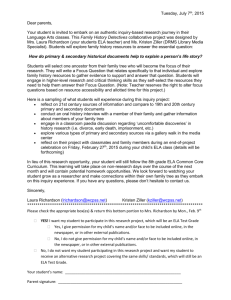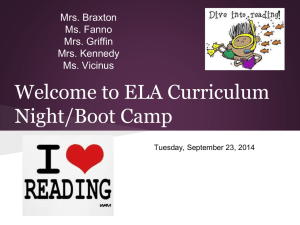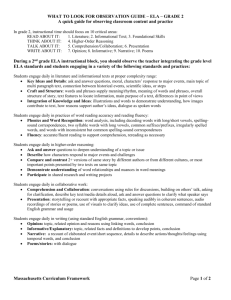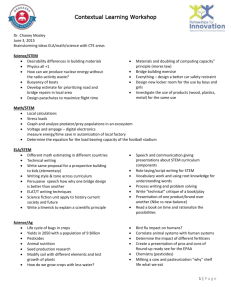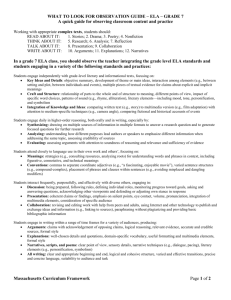Kindergarten Visual Art Standards Map
advertisement
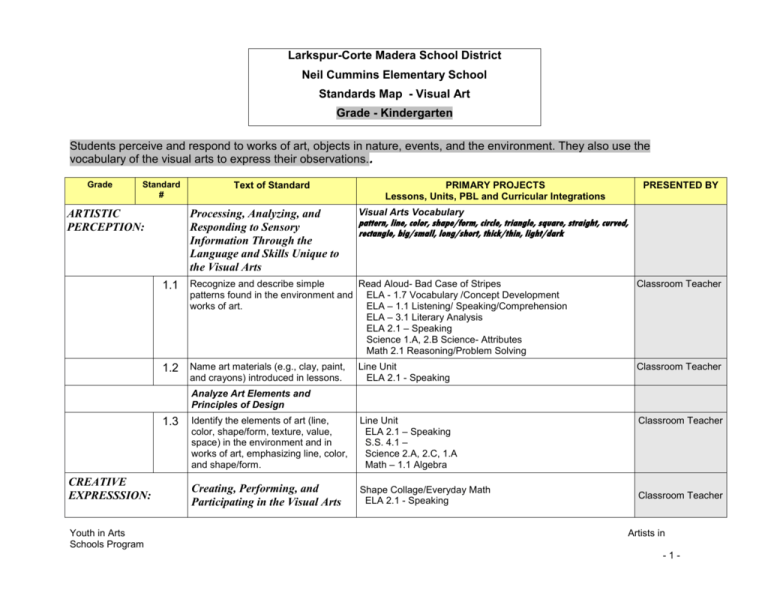
Larkspur-Corte Madera School District Neil Cummins Elementary School Standards Map - Visual Art Grade - Kindergarten Students perceive and respond to works of art, objects in nature, events, and the environment. They also use the vocabulary of the visual arts to express their observations.. Grade Standard # ARTISTIC PERCEPTION: Text of Standard Processing, Analyzing, and Responding to Sensory Information Through the Language and Skills Unique to the Visual Arts 1.1 Recognize and describe simple PRIMARY PROJECTS Lessons, Units, PBL and Curricular Integrations PRESENTED BY Visual Arts Vocabulary pattern, line, color, shape/form, circle, triangle, square, straight, curved, rectangle, big/small, long/short, thick/thin, light/dark Read Aloud- Bad Case of Stripes ELA - 1.7 Vocabulary /Concept Development ELA – 1.1 Listening/ Speaking/Comprehension ELA – 3.1 Literary Analysis ELA 2.1 – Speaking Science 1.A, 2.B Science- Attributes Math 2.1 Reasoning/Problem Solving Classroom Teacher Line Unit ELA 2.1 - Speaking Classroom Teacher Identify the elements of art (line, color, shape/form, texture, value, space) in the environment and in works of art, emphasizing line, color, and shape/form. Line Unit ELA 2.1 – Speaking S.S. 4.1 – Science 2.A, 2.C, 1.A Math – 1.1 Algebra Classroom Teacher Creating, Performing, and Participating in the Visual Arts Shape Collage/Everyday Math ELA 2.1 - Speaking patterns found in the environment and works of art. 1.2 Name art materials (e.g., clay, paint, and crayons) introduced in lessons. Analyze Art Elements and Principles of Design 1.3 CREATIVE EXPRESSSION: Youth in Arts Schools Program Classroom Teacher Artists in -1- Grade Standard # K 2.1 Use lines, shapes/forms, and colors to make patterns. Pattern Blocks/Patterning with Pasta Bead necklaces ELA 2.1 Speaking Science 1.A, 4.C Math 1.1 Algebra Classroom Teacher K 2.2 Demonstrate beginning skill in the use of tools and processes, such as the use of scissors, glue, and paper in creating a three-dimensional construction. 3D Sculpture – S.S. 4.1 Science 4.C, 4.B Math 2.2 Statistics Classroom Teacher K 2.3 Make a collage with cut or torn paper shapes/forms. Teddy Bear Art Torn Paper Collage Torn Pumpkin Science 4.B, Math 2.2 Statistics Art Teacher Text of Standard PRIMARY PROJECTS Lessons, Units, PBL and Curricular Integrations PRESENTED BY Communication and Expression Through Original Works of Art K 2.4 Paint pictures expressing ideas about Painting at Easel/Classroom painting family and neighborhood. Science 4.E Classroom Teacher K 2.5 Use lines in drawings and paintings to express feelings. Line to Music Classroom Teacher K 2.6 Use geometric shapes/forms (circle, triangle, square) in a work of art. Directive Drawing S.S. 4.1 Math 2.2 Statistics Matisse Collage – S.S. 4.1 10 Black Dots – ELA, S.S. 4.1, Science 4.D, 4.E Pattern Block Art Classroom Teacher K 2.7 Create a three-dimensional form, such as a real or imaginary animal. Clay Animals Science 2.C, 2.B HISTORICAL AND CULTURAL CONTEXT Youth in Arts Schools Program Understanding the Historical Contributions and Cultural Dimensions of the Visual Arts Artists in -2- Grade Standard # K 3.1 Describe functional and nonutilitarian art seen in daily life; that is, works of art that are used versus those that are only viewed. K 3.2 Identify and describe works of art that Todd Parr – It’s OK – show people doing things together. Science 4.E Mural – S.S. 1.2, 1.3, ELA 2.1, ELA 2.5 Tech Integration Text of Standard PRIMARY PROJECTS Lessons, Units, PBL and Curricular Integrations Pinch PotsScience 3.C Resources, 4.A Five Senses Paint Flower Pot Frame Painting Journals – ELA Writing 1.1, 1.2, 1.3, 1.4, ELA Listening /Speaking 1.2 Speaking 2.3 PRESENTED BY Classroom Teacher Classroom Teacher Diversity of the Visual Arts K 3.3 AESTHETIC VALUING Look at and discuss works of art from Talk about Artists a variety of times and places. S.S. 6.2, 6.3 My Father’s Dragon S.S. 6.2, 6.3 Three Bears S.S. 6.2, 6.3, ELA 3.1 Math 1.2 Measurement Classroom Teacher Responding to, Analyzing, and Making Judgments About Works in the Visual Arts K 4.1 Discuss their own works of art, using appropriate art vocabulary (e.g., color, shape/form, texture). Refection and Sharing about Art S.S. 1.1, ELA – Vocabulary 1.1, K 4.2 Describe what is seen (including both Picture Walk literal and expressive content) in S.S. 1.1, ELA Vocabulary 1.1, selected works of art. ELA 2.3 Speaking, Science 4.E Classroom Teacher Classroom Teacher Make Informed Judgments Youth in Arts Schools Program Artists in -3- Grade Standard # K 4.3 Discuss how and why they made a specific work of art. Refection and Sharing about Art S.S. 1.1 ELA Vocabulary 1.1, ELA 2.3 Speaking Science 4.E Classroom Teacher K 4.4 Give reasons why they like a particular work of art they made, using appropriate art vocabulary. Refection and Sharing about Art S.S. 1.1 Gallery Walk - S.S. 1.1 Quilts - S.S. 1.1 ELA Vocabulary 1.1, ELA 2.3 Speaking, Science 4.E Classroom Teacher CONNECTIONS, RELATIONSHIPS, APPLICATIONS Text of Standard PRIMARY PROJECTS Lessons, Units, PBL and Curricular Integrations PRESENTED BY Connecting and Applying What Is Learned in the Visual Arts to Other Art Forms and Subject Areas and to Careers K 5.1 Draw geometric shapes/forms (e.g., circles, squares, and triangles) and repeat them in dance/movement sequences. Dance- Standard 1 – Movement elements and skills Classroom Teacher S.S. 4.1, P.E. 1.4, 1.5, 1.10, Science 4.E, Math -2.1 Statistics Art Teacher Visiting Artists Motor Skills Teacher K 5.2 Look at and draw something used every day (e.g., scissors, toothbrush, fork) and describe how the object is used. Daily Journal – SS 5.1 Free Choice Drawing and Painting SS 5.1 Classroom Teacher Symbols (State and National) SS 2.0, 4.1, 4.3, 4.4, ELA Vocabulary 1.1, ELA 2.1 Speaking Science 4.E Science 4.E Classroom Teacher Visual Literacy K 5.3 Point out images (e.g., photographs, paintings, murals, ceramics, sculptures) and symbols found at home, in school, and in the community, including national and state symbols and icons. Career and Career-Related Skills Youth in Arts Schools Program Artists in -4- Grade Standard # K 5.4 Youth in Arts Schools Program Text of Standard Discuss the various works of art (e.g., ceramics, paintings, sculpture) that artists create and the media used. PRIMARY PROJECTS Lessons, Units, PBL and Curricular Integrations Famous Artists ELA 2.1 Speaking SS 6.3 PRESENTED BY Classroom Teacher Art Teacher Artists in -5-

